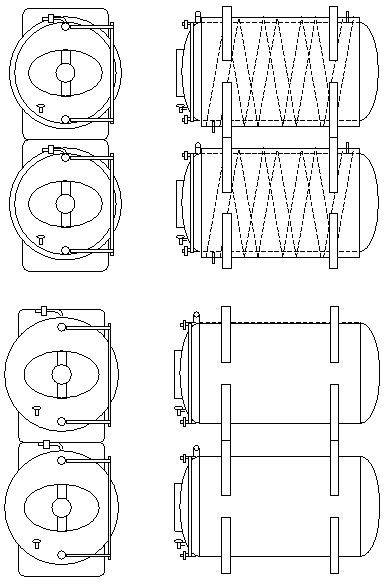BBT | Bright beer tanks | Serving tanks | Conditioning tanks | Beer storage tanks
– serving pressure vessels for storage of drink and filling of drink into the kegs and bottles
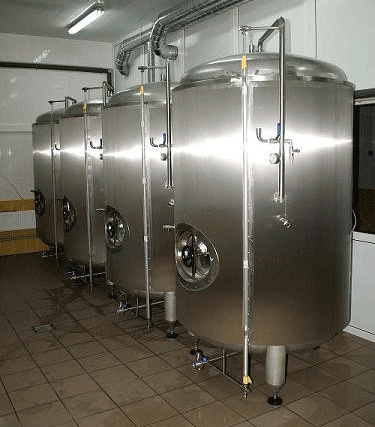

After completion of the maturing phase of production in maturing tanks or cylindrical-conical tanks ( depending on the selected fermentation technology ) the beer is tapped into the serving tanks. Service tanks (storage tanks), also called bright beer tanks, are the containers structurally identical to the beer maturation tanks.
Their typical feature is the certification for pressure 3.0 bar , since for their main function, which is filling the transport packaging ( kegs, bottles ) and draught beer ( in the adjacent restaurant ), it is necessary to keep beer under a higher pressure than is used in maturing tanks.
Serving tanks / Bright beer tanks that are manufactured and supplied for our breweries and cider houses are designed as “combi-serving tanks“. This means that these containers allow for both filling and bottling of beer or cider, and their maturation in lager cellar. These combi-service tanks are the same parameters as the maturing tanks, but always are designed for max. 3.0 bar overpressure and are individually tested by PED qualified personnel. Therefore, they are pressure vessels according to PED (Directive 97/23 / EC).
Optionally we can produce the pressure equipment according to the conditions and standards of GOST-R or GUM certification rules. In this case, we charge an extra surcharge for the special certification :
- PED certification … is included in the price
- GUM certification … surcharge 10% – We ensure all necessary technical equipment of the tank (GUM compliant), a customer pays and handles the certification process for the tank on site.
- GOST-R certification … surcharge 10%
It means that any maturing tank can also be used as a serving one and vice versa. This solution simplifies and accelerates the process of beer production because it is not necessary to pump beer from storage tanks to service tanks but simply by increasing the pressure in the maturing tank we can change its service in a few seconds without other interventions.
Position of serving bright beer tanks in typical Czech brewery :
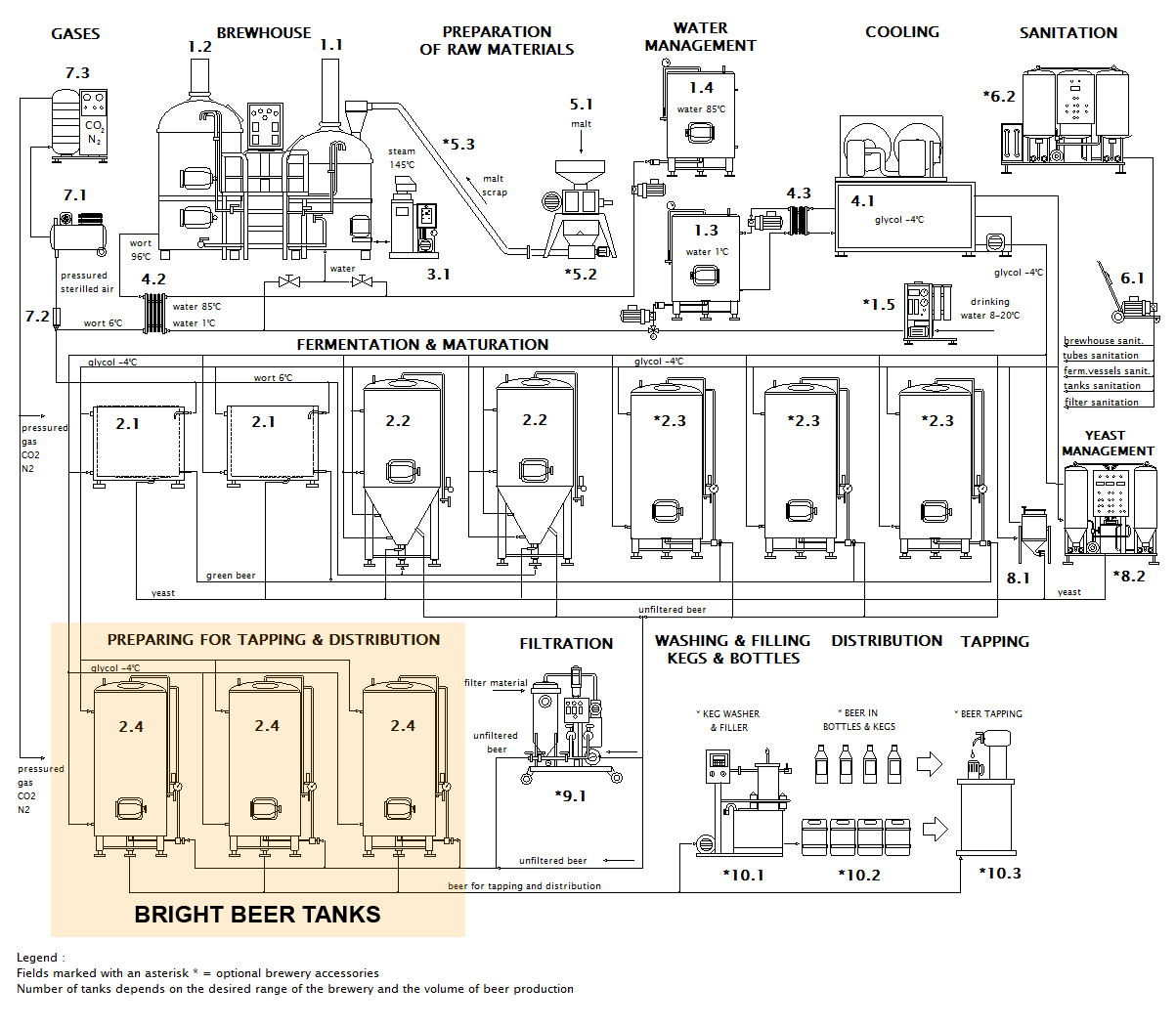
Function of the bright beer tank is gaining its importance especially in breweries, from which the beer is filtered and subsequently distributed in bottles and transported in barrels to other restaurants or to sale networks . After completion of maturation , the beer is filtered and subsequently tapped into serving tanks.
Here the beer is left to calm down, for several hours or days , without further intervention . From the serving tank after increased pressure in the tank it is subsequently tapped into shipping containers into the contra-pressure, to avoid the loss of the carbon dioxide from the beverage.
We also manufacture service tanks as dedicated containers for bottling and tapping of beer and cider (Bright beer tanks) according to customer’s request. These tanks don´t contain an equipment for the maturation of beer or cider (they can not be used as lagering tanks).
We optionally offer the serving and combi-serving tanks with carbonating candles. This device is often used for additional carbonating of beverages by carbon dioxide – for example in the production of drink cider.
Equipment of the bright beer tank (insulated, vertical, cooled with water/glycol) :
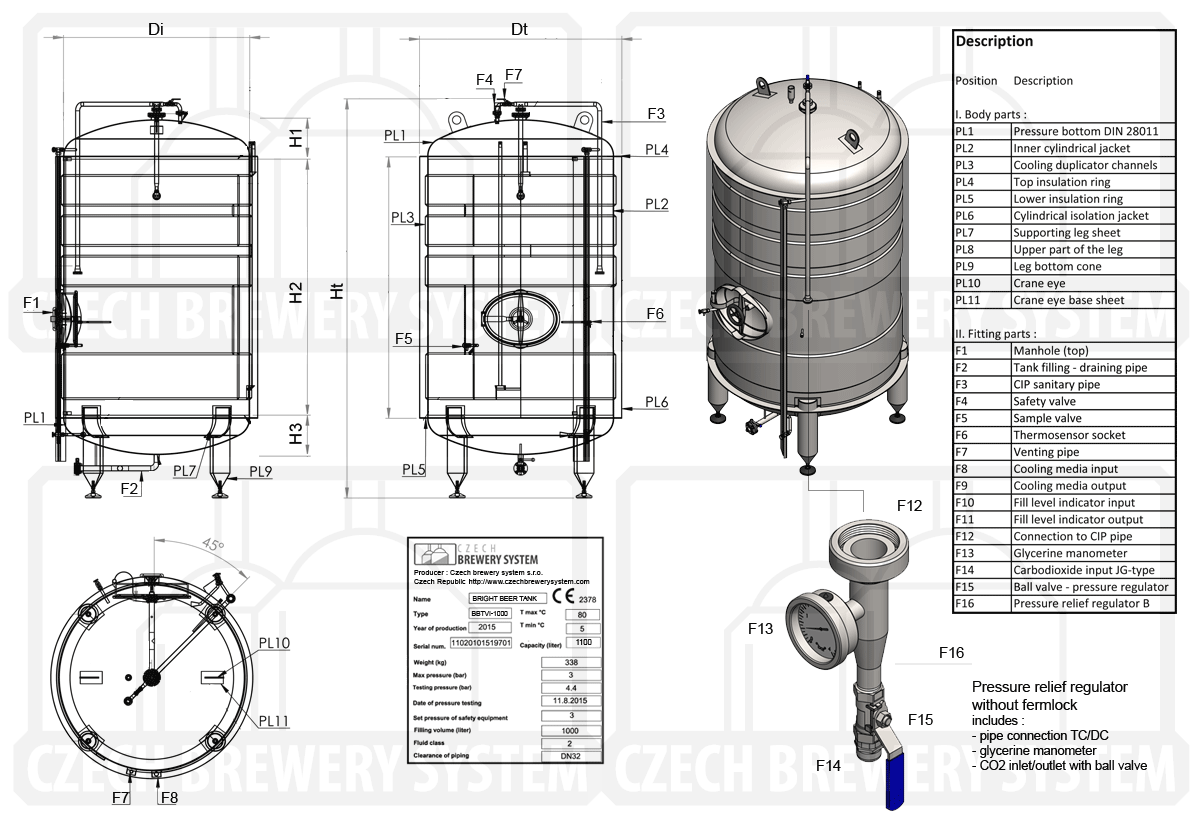
Equipment of the bright beer tank (non-insulated, horizontal, cooled with air) :
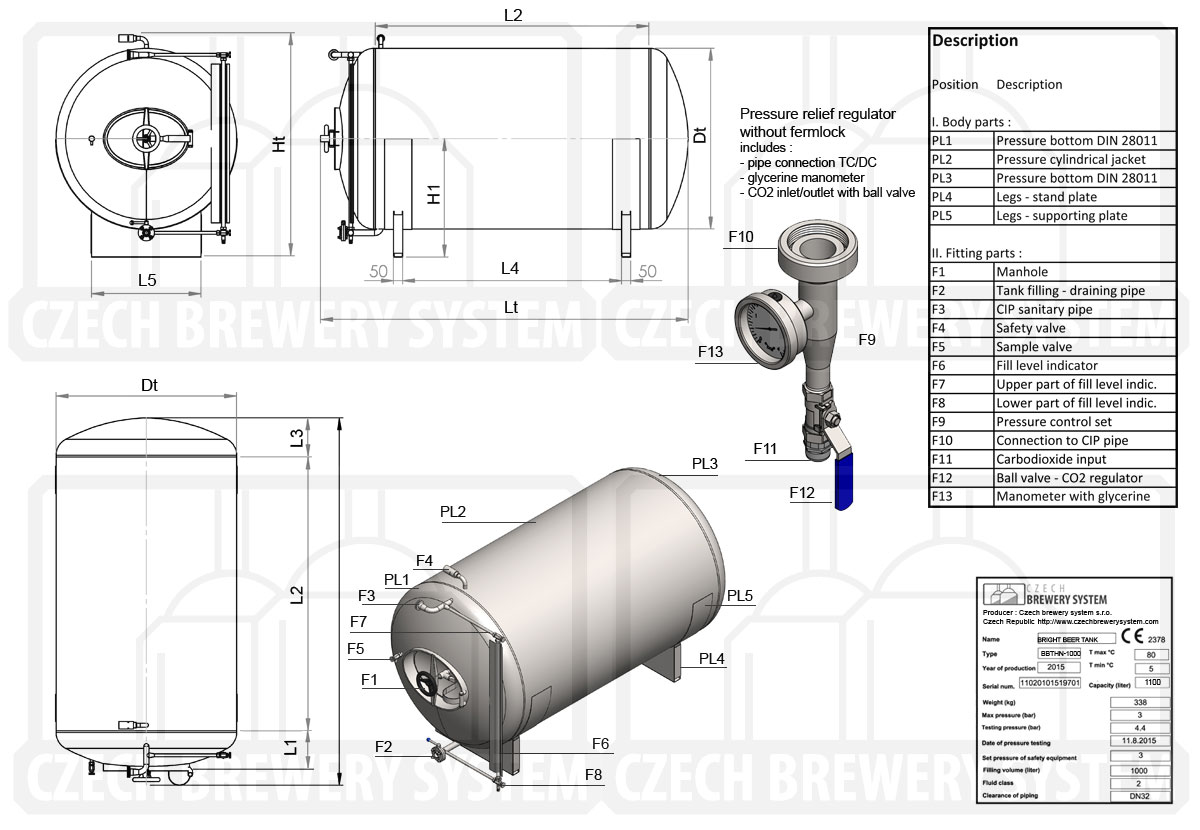
Standard equipment – description
- Pressure relief valve – Overpressure setting mechanism with a glycerin manometer (standard range from 0 to 3 bar ) – necessary for keeping beer under pressure during all in-tank operations
- Cooling channels – duplicators for circulating of coolant in the cooling jacket (one, two or more according type of the tank)
- PUR insulation – polyurethane insulation with thickness according to the size of the tank and the target environment (standard = 50mm )
- Stainless steel jacket – with the customer selected surface finishing (standard = grinded)
- Guaranteed inner surface roughness : Ra < 0.8 μm or less (grinded surfaces) / Ra < 0.5 μm or less (polished surfaces)
- Inspection manhole on the upper arched bottom or on-site on the cylinder part, according to customer requirements (SQ = open inside / HQ = open outside)
- Tank draining outlet / inlet with a butterfly valve for filling tank, discharging of yeast and draining of full content of the tank
- Sanitation sprayball – CIP sprayball (SQ = statical / HQ = rotational) – one or more pcs
- Sanitation pipe – a multifunction pipe with a ball valve for connection of a sprayball, CIP station (cleaning, sanitizing), the relief valve with manometer, CO2 inlet
- Sample valve – cleanable and sanitizable sampling cock for collection product samples
- Safety valve – double-acting overpressure (standard = 3.2 bar) and vaccum protection (0.2 bar) safety valve – only pressure version of the tank
- Venting valve – dedicated valve for safety draining of the tank and for accurate measurement pressure in the tank with manometer (when the sprayball is glued with foam)
- Thermometer socket – welded socket for inserting of thermosensor or thermometer (one or more according type of the tank)
- Manometer – included in the pressure relief valve set, stainless steel, glycerine
- Fill level indicator – cleanable and sanitizable glass pipe for visualisation of product level in the tank (SQ = fixed / HQ = removable)
- Crane eyes – steel welded handles for safety transport of the tank with crane or forklift
- Legs with adjustable feet – 3 or 4 legs with rubber feet for accurate adjusting of the tank on an uneven floor
- Type label – the steel label with all parameters that are required from European Union for pressure vessels
- PED 2014/68/EU certificate – the European certificate for the overpressure vessel + passport document of the pressure vessel
Optional equipment – description
- Relief valve with a fermlock – a special armature that is designet to controlled fermentation/maturation of the product under pressure (for a beer maturation process inside the tank)
- Yeast outlet separator – a special removable short pipe that is designed to easy separation of yeast under a bottom from clear product above the yeast layer
- Special manholes – secondary site manhole, manhole with sightglass, manhole with glass door
- Special sprayballs – rotational, pulse or other special cleaning equipment for powerfull cleaning of the tank
- Side or upper universal armature – for dry hopping , flotation, carbonation stone etc.
- Scale for the fill level indicator – a liter scale on a cover of the fill level indicator for visualization of the current product volume in the tank
- Scale for the pressure relief valve – a bar scale on a relief valve screw for indication of just required pressure in the tank (a manometer shows the current pressure)
- Temperature measurement and regulation components – we deliver more types of thermosensors, thermometers and also fully equipped temperature control systems for our tanks
- Thermometer, thermocouples, thermoregulators – more types for installation directly on the tank or on a wall
- Automatic thermo regulation valves for regulation the coolant flow in the cooling channels
- On the tank thermo controller – for measurement and regulation temperature directly on each tank
- On the wall thermo controller – for measurement and regulation temperature in more tanks from a common switchboard cabinet
- Automatic tank temperature measurement and control system – for an automatic control of full fermentation and maturation processes
- Carbonation stone – the special jet for carbonation of beverages from CO2 bottles
- Ladder – for easy operating with manholes and other upper accessories of tanks
- Tank product filling hub – a special tool to easy filling of product (like beer wort , cider must) to the fermentation tank
- Tank stirring equipment – to stirring contents of the tank, It is mounted on the side of the tank shell
- Other customizations of the tank – according on customer´s requirements – non-standard dimensions, special armatures, special surface and design of the tank etc.
The Guide the four types of pressure bright beer tanks in our offer
We manufacture and supply bright beer tanks in various designes with our microbreweries:
I. Types of bright beer tanks according to the the design of a cooling method:
1. Serving bright beer tanks with single-jacket (air-coolled)
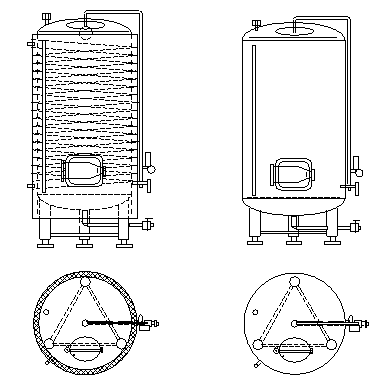 Simple and cheap non-insulated tanks , cooled by cold air. The traditional way of cooling bright beer tanks . The advantage is low cost, but there is also number of disadvantages: high cooling energy demands (it can be affected by the quality of the thermal insulation of walls in the lager cellar) , low comfort of work in the cooled beer storage room.
Simple and cheap non-insulated tanks , cooled by cold air. The traditional way of cooling bright beer tanks . The advantage is low cost, but there is also number of disadvantages: high cooling energy demands (it can be affected by the quality of the thermal insulation of walls in the lager cellar) , low comfort of work in the cooled beer storage room.
It is necessary to note that for the brewery cellar with single-shell tanks it is needed to create a cooling box, a room with very good insulation of walls and ceiling and with a refrigerator door. The operating costs of cooling are particularly during the summer months, possibly year-round in tropical areas, significantly higher than the lager cellar with insulated tanks cooled by liquid. These increased costs to the building and operation usually outweigh the savings from buying cheaper technology brewery.
In contrast, the solution is usually advantageous for air cooling Microbrewery what need to create a refrigerated storage area for filled kegs or bottles of beer, and have not a dedicated storage room. In this case, together with the beer for sale are simultaneously cooled also lager tanks.
2.Serving bright beer tanks with double-jacket (liquid cooled)
– more elaborate insulated tanks, cooled by glycol or ice water circulating in the double jacket duplicators. The modern way of cooling a lager cellar, which is standard in modern breweries. Besides the apparent disadvantage of the higher initial cost, these tanks have only advantages: low cost of cooling operation (cooling only beer, not space), low demand at the place of installation (no need to insulate storage cellar, tanks can be in any room), comfortable operation (in the room with tanks is not need to regulate the teperature ). possibility to control temperature in each tank separately. The only suitable solution for automated management system of the brewery.
II. Types of bright beer tanks according to the spatial orientation:
1.Serving bright beer tanks vertical
– tanks in a brewery are “standing”. Easy for cleaning and sanitation and there is also easy access to the tanks from all sides. The disadvantage is the space requirement both in height and in the area of beer cellar. Vertical bright beer tanks are standard in modern breweries and this concept is preferred where small space is no fundamental limitation.
2. Serving bright beer tanks horizontal
The advantage is saving place. In the same area we can place a greater number of tanks, if they are arranged in the battery, i.e. several rows one above another. The disadvantage is the difficult cleaning and sanitation of the tanks stored too low or too high. Battery tanks are difficult to clean from outside – in inaccessible surfaces of tanks organic contaminants may accumulate and contaminate the produced beer.
Price list and description of serving tanks – four variants :
- Serving tanks, bright beer tanks – insulated, vertical, liquid cooled
- Serving tanks, bright beer tanks – non-insulated, vertical, air cooled
- Serving tanks, bright beer tanks – insulated, horizontal, liquid cooled
- Serving tanks, bright beer tanks – non-insulated, horizontal, air cooled
